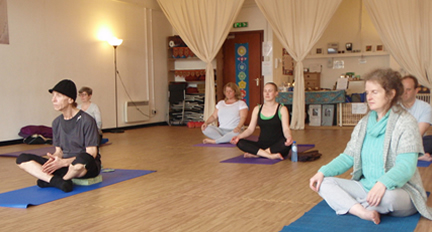
This question comes up repeatedly in classes, especially when “om” is part of a mantra being chanted. Many people associate “om” with Hinduism, which can be disturbing to non-Hindus who are asked to chant “om” in a yoga class.
But there is not one simple translation for “om” or any of the other mantras in the Sanskrit language. Sanskrit, itself, has deeply ancient origins and may be the oldest language in the world. Unlike English, in which the communication of meaning is paramount, Sanskrit gives sound the highest priority. Sound carries the meaning, and meaning is in the sound. Each letter of the Sanskrit alphabet has its own energetic quality.
But what exactly is a “mantra”, you might ask. David Frawley explains in Mantra Yoga and Primal Sound, “Mantra in Sanskrit means tool ‘tra’ of the mind ‘manas.’ It is the primary tool of Yoga for calming the mind…”
Mantra has the deeper meaning of “that which protects or supports.” Often a teacher gives a student a “mantra” to help support him or her. The mantra unfolds itself to the student as it touches all parts of his or her system.
“Om” has a place in Indian mythology. As the story goes, the universe resounded with the sound and vibration of “om” at the moment of creation. Often people recognize a power in the vibrational quality of the sound as they chant it. Many experience a quieting of the mind and a calming energy when chanting “om.”
The mantra “om” comes from the sounds of “a+u+m+silence.” When chanted, the “au” or “o” has three counts, the “m” has one-half count, and then momentary silence. “Om” represents everything in creation; the silence after “om” represents that which is beyond words. Other meanings are attributed to the mantra as well. For example, “a” can represent the teacher; “u” the student; “m” their relationship. The letter “a” can stand for creation; “u” for that which sustains; “m” for dissolution. The mantra can represent the states of consciousness: “a” representing waking; “u” representing dreaming; “m,” deep sleep.
“Om” also represents a higher force. It can be the highest within you, a heart quality, love. It is a force above or beyond the mind. And, yes, when Hindus chant “Om,” it represents God.
“Om” has a mystery to it, even when we hear it without chanting ourselves. This mystery comes from the power of the vibration and sound, which is able to touch us deeply. The effect can be profound and even healing. But, let me be clear: there is no requirement in yoga to chant “om” or anything else. It is another modality to explore and to see from that exploration what might be discovered.
